Kwame Akoto-Bamfo is a Ghanaian artist creating thought-provoking sculptures that tell the African story. In this interview, he shares his process, his biggest installation, and future plans.
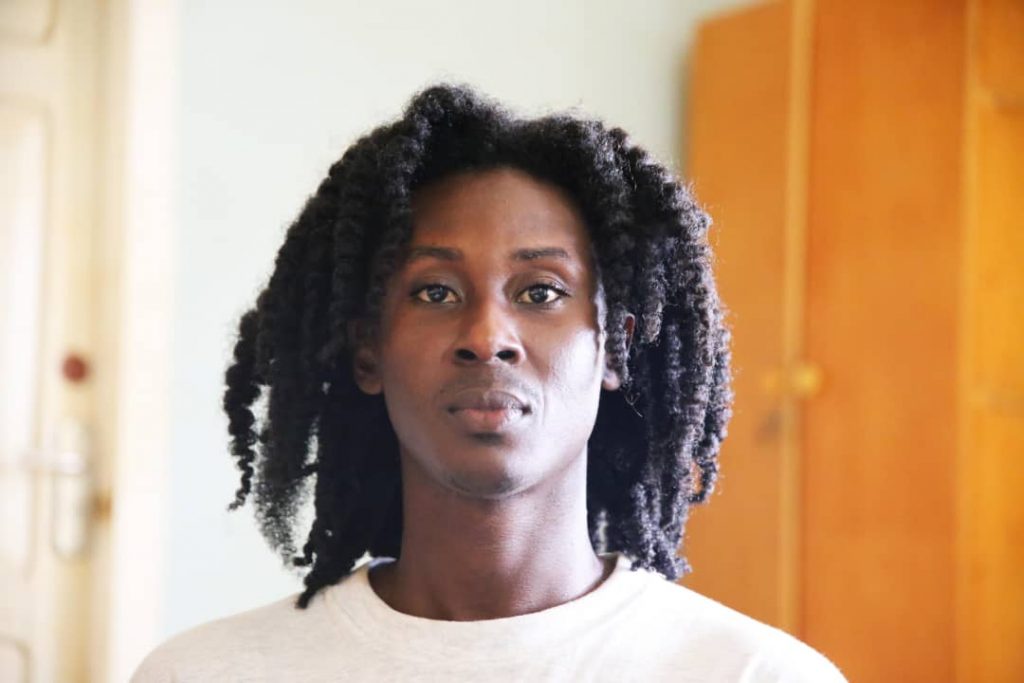
For 400 years, approximately 12 million Africans were transported from their homes across the Atlantic to the Americas as slaves and forced to work in mines and plantations. Kwame Akoto-Bamfo, a Ghanaian artist, has spent 6 years sculpting about 1,300 heads that depict the dehumanizing trade manipulation and exploitation which happened from the 16th to 19th century. These heads, a part of his Nkyinkyim installation, pay homage to the ancestors who fell victim to the transatlantic slave trade and portray their ordeal several years ago. No two heads look the same. Some heads portray the particular state the slaves were in when they were captured, with them looking unto the instrument of their destruction. Other heads represent those who were prisoners of war. He chose to use heads for his portraits because it also pays homage to the ancient Akan practice of creating memorial heads – nsodie (to put something unto something) – for royalties when they pass away. In 2017, the heads were displayed at the Cape Coast castle for his exhibition, “In Memoriam: Portraits of the Middle Passage, In Situ,” and have recently found a home in an open field next to his Osramba studio in Nuhalenya, Ada.
Akoto-Bamfo is also an educator, cultural activist, and patron of the Nuhalenya, Ada community. In 2015, he won the Kuenyehia Prize for Contemporary Ghanaian Art. With a BFA in sculpture and a Master’s Degree in Fine Art, Kwame enjoys experimenting with different techniques. His other works consist of wood carvings, 3D models and he has dabbled in animation. He created the Ancestor Project which has evolved from being a movement to a non-profit organisation, to create a consciousness around African art, history, and heritage. He says it is a conscious effort by its participants to promote African heritage values through the use of art, music and performance art. It is also the vehicle through which his social and cultural work including the Nkyinkyim installation thrives.
In this interview, Kwame shares his work process, he talks me through the Nkyinkyim installation and what it would look like as an open-air museum when it’s completed.
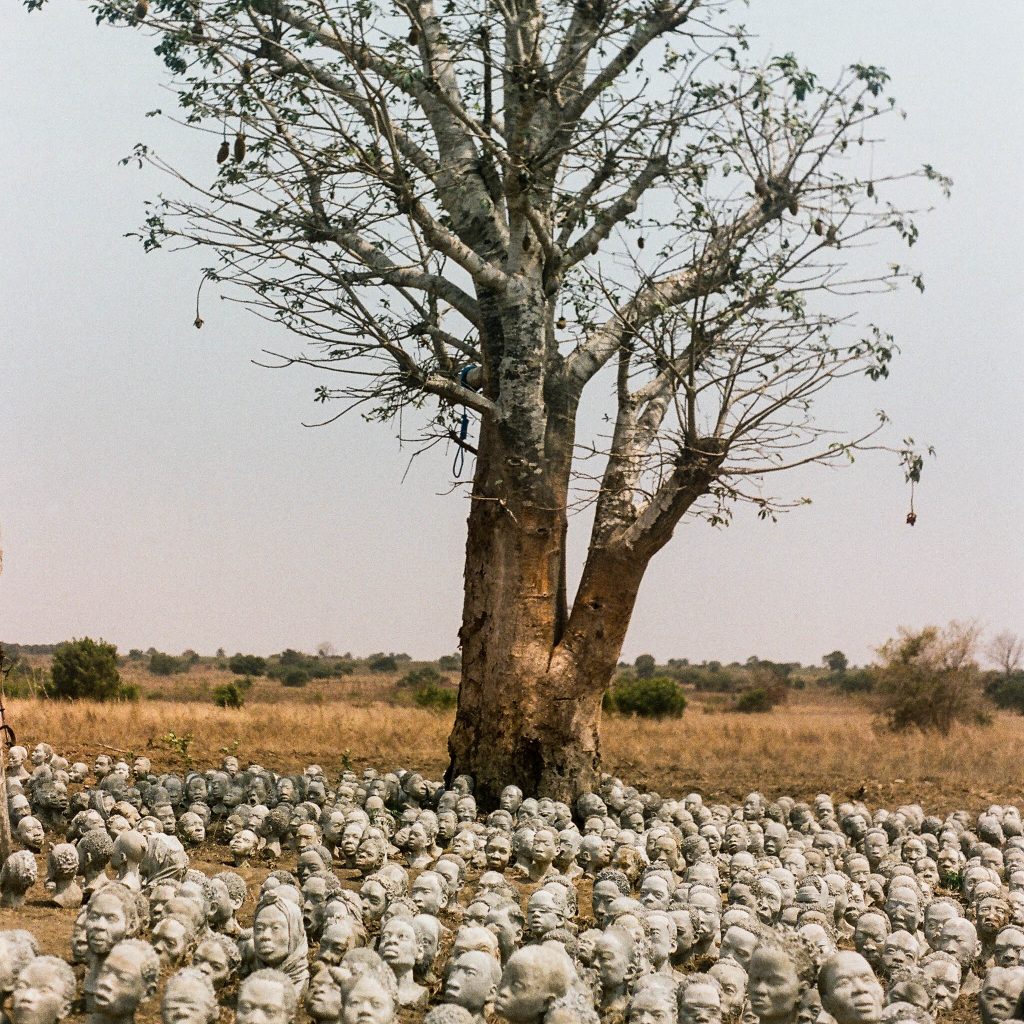
Angela Okorie: Let’s begin with your work process. Take me through the process from design to the finished work.
Kwame Akoto-Bamfo: Like most artists, I get my inspiration from life. Over the years, I have been particularly drawn to African culture and history, so I would say they are my main sources of inspiration. I also get inspiration from nature and African philosophy. As an artist who works with a variety of techniques and materials, and who also combines both digital art and the traditional media process, it is imperative that I preconceive my processes before I start. I stick strongly to a design process, research, thumbnails and then final work, especially for commissioned projects. Due to the scale of my work, I stick to a 70% structured design process or methodology and leave the rest mainly to intuition. So a major part of the completed work is preconceived design, but there’s always space for pure intuition. That’s the only way I can enjoy the process of creation. If I can fully tell how a particular piece would turn out, I lose interest in it and I’m unable to complete it.
Sometimes, I get to be spontaneous. For example, I could see a log of wood and create something out of it.
AO: What material(s) do you favour?
KAB: I would say I favour wood, but only because I miss carving after working with clay and concrete for a long time. I think it’s hard to tell if I have a favourite material to work with. Whenever I work with one material for a long time, I start to miss the others. When I miss a particular material, I’m more likely to mention that as my favourite when the question is asked. In all, I do enjoy carving out things that are very challenging.
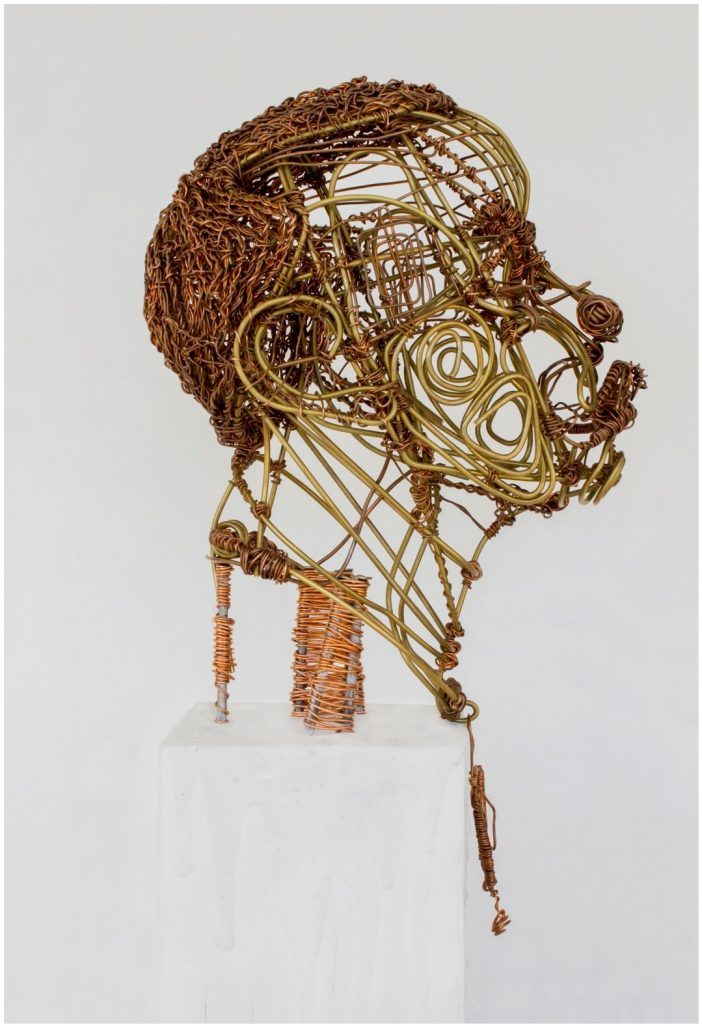
AO: I’m interested in knowing how people have engaged with one of your projects – The Nkyinkyim installation which records African history, from prehistory until now, where a section consists of about 1,300 heads which explore the transatlantic slave trade. What kind of emotional response does it elicit from the people who have experienced it in the past?
KAB: For the past 3-4 years, people have only interacted with the transatlantic slave trade section of the installation. In the past year, we have been working on other sections of the installation, so people have not had the chance to engage with that yet, because a lot of the pieces have not been installed.
I mostly get a lot of emotional feedback; remorse, anger, self-denial and a lot of sadness. Usually, when it is face to face with the work, because I tend to guide the conversation, it is more sadness than anger. The response is different online because there’s nobody curating the narrative. Then, it’s mostly anger, and sometimes it is admiration and sadness. Sometimes the anger is directed towards me. There are people who feel I am adding to their trauma. They believe I’m aiding in the depiction of Africans as slaves. A few do not think I have the right to tell the story. I think a lot of these reactions stem from ignorance and they fail to understand why these sculptures were created and the importance of doing so. 5 years ago, people reported the work to Facebook for the images to be taken down, because they felt it was too gruesome. It brings a lot of emotions to the surface. And these emotions, whether they are positive or negative, tend to be intense.
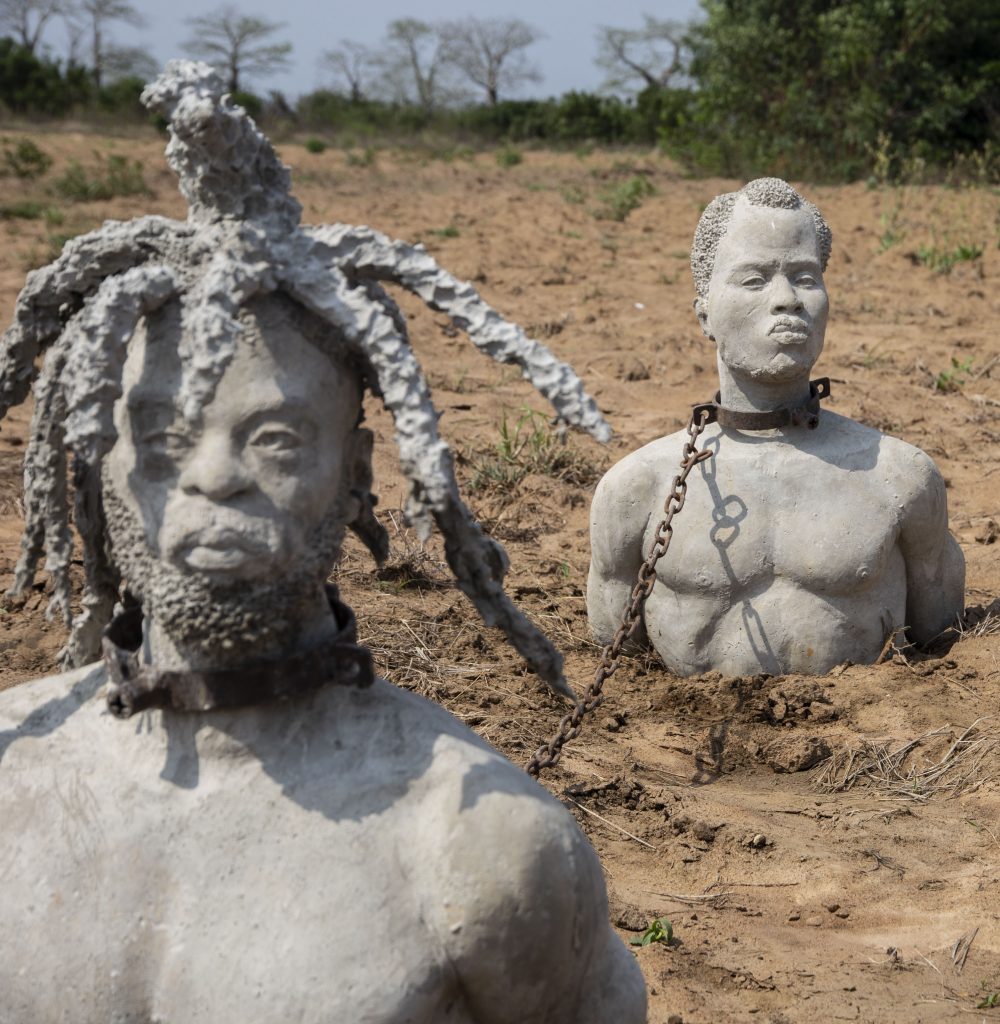
AO: Are there other narratives/themes you have explored in your work?
KAB: I also work on the concept of balance and the contrasting ideas of negative and positive matter, but the elements in the Nkyinkyim installation have drowned other concepts that I tend to explore in my work.
AO: I think we have started to reimagine our museums in order to create new narratives and structures that encompass rather than exclude, and unapologetically tell our stories. For example, the Nkyinkyim installation is on its way to becoming an open-air museum. What would it look like?
KAB: It is going to cover more than 50 – 100 acres. I can only describe to an extent but considering that I like to structure only about 70% of my work, it might still elude you. The unmentioned 30% of the work may end up being 20 acres of missing information. I can only say that it will include a lot of materials, terracotta, wood, iron, concrete, living plants, and it is going to include life-sized traditional houses on African architecture. It would be fully integrated with performance art. It is going to be the largest art project I have ever worked on. It would take between 5-15 years to complete because I’m not only concentrating on material culture but also on living culture. It is going to be ephemeral with medium-short lifespan sections. I believe it will evolve, because it includes plants and other transient materials, which is going to keep changing till the day I pass away. I have made provision for that occurrence and it has affected the way I choose to approach the project. I want to see things deteriorate with us replacing them. It is part of living culture, it is something that is continuous. There will be sections that will be permanent and longer-lasting with materials like brass, bronze, and other metals.
AO: Now that the notion of museums is being challenged, what would the future of African museums look like?
KAB: Africans are learning a lot more from each other now than in the past because technology has made it easier for us to be able to do so. The panoramic view of African art and culture is that even though we have had similarities in our art, we were not always aware or even if we were, we didn’t pay attention. But facing what we have experienced over the years; racism, colonialism, and common difficulties, I think we have started to work towards a united story. That united story I’m predicting will evolve from us showing colonial concepts of what we think African art should be, to being a truer and free representation of African art and culture, which is what I’m trying to do with the Nkyinkyim installation. I predict that I will influence a lot of people, and I will be influenced by other people as well in the direction I want to go. I know that for now, especially in Ghana, we are beginning to have a clearer idea of African art. Within the next year, we will have fewer people trying to build to please the west but to satisfy our needs.
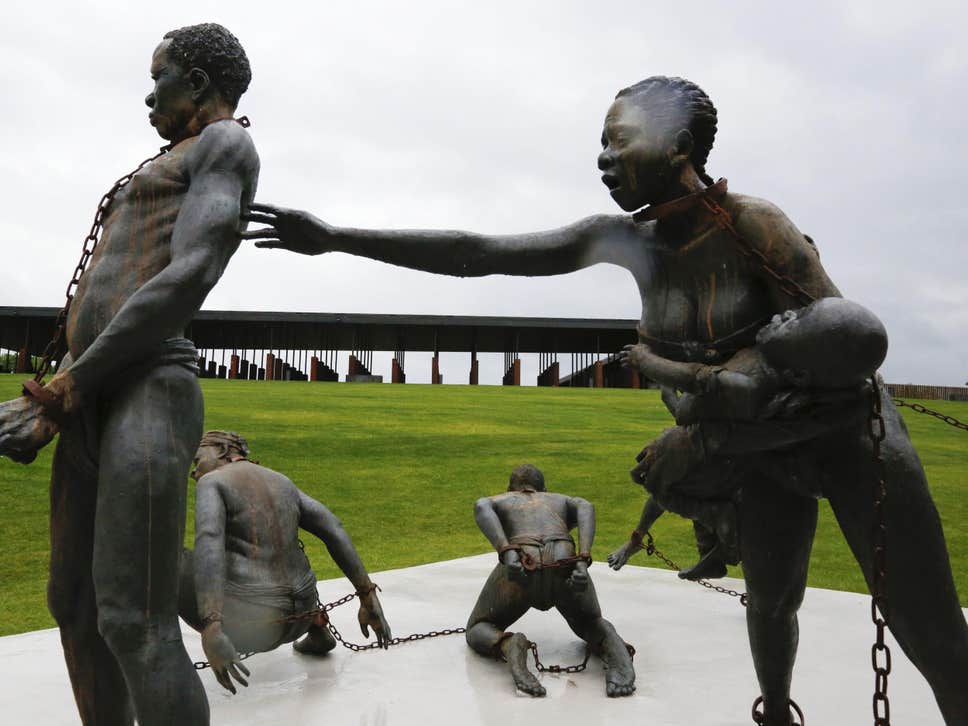
AO: Do you have other works that exist in public spaces? And has your sculptural work always been on a grand scale?
KAB: In Ghana, yes. Some of my pieces have existed for a number of years and I have had them installed in public spaces, with a few of them in the possession of private collectors. My work is currently at the National Memorial for Peace and Justice in Alabama. I also worked on a bottle for Coca-Cola’s 100 year anniversary about 3 years ago. The visible part was about 20ft high, and 7ft below ground, which makes it the largest piece I have ever created.
For wood carvings I have done pieces that were 7ft high. When it comes to large scale projects, the Nkyinkyim is the largest I have done so far. The 25ft pieces would seem very small in comparison to the installation. I currently have two pieces that are a work-in-progress. They are both about 23- 25ft each.
AO: Do you have a sense of how your sculptures or technique would change? What are you thinking now, and how do you think this would change in the next 3-5 years?
KAB: My sculptures will definitely change. You have to be very observant to be able to see that they have been changing a lot over the years. I intentionally allow a couple of ideas to run through just so people are not confused when they are trying to find out what I do. So yes, it is definitely going to change a lot. I have become more relaxed and open to contributions from other artists over the years. I see that affecting the way I work. I am also learning daily and picking up on the speed in which I do portraits. When you work on large scale projects often, it changes your speed and also your appraisal. I have had the opportunity to experiment with a lot of techniques for creating my work. When I start to see the results from my experiments and evolving techniques as the years go by, I think it would affect my style and methodology within the next 5 years.
Kwame Akoto-Bamfo
Website: https://kwameakotobamfo.com/
Instagram: @osramba_media
__




